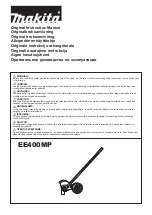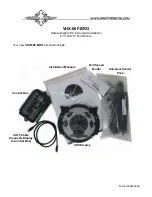
SPECIFICATIONS
A S w e e p t i m e : 2 0 n s / d i v t o 0 . 5 s / d i v in 2 3
ranges, in 1 - 2 - 5 sequence,
verninier control provides
fully adjustable s w e e p t i m e
b e t w e e n steps.
B S w e e p t i m e : 2 0 n s / d i v t o 5 0 m s / d i v in 2 0
ranges, in 1 - 2 - 5 sequence.
Accuracy: + 3 % ( 1 0 ~ 3 5 ° C )
± 6 % ( 0 ~ 5 0 ° C )
S w e e p magnification: X 1 0 ± 5 % ( 1 0 ~ 3 5 ° C )
± 7 % (0 ~ 5 0 ° C )
Linearity: 2 0 n s / d i v t o 0 . 5 s / d i v ± 3 %
( ± 5 % w i t h X 1 0 magnification)
H O L D O F F : Continuously adjustable for A
S w e e p hold off t i m e f r o m
N O R M t o X 5 .
Trace separation: B positionable u p t o 4
divisions separated f r o m A
S w e e p , continuously adjustable.
Delay m e t h o d : Continuous delay. SYNC delay
Delay t i m e : 0 . 2 t o 1 0 t i m e s t h e s w e e p t i m e
f r o m 2 0 0 n s t o 0.5s, c o n t i n u -
ously adjustable.
T i m e difference m e a s u r e m e n t accuracy:
± 2 % ( 1 0 ~ 3 5 °C)
± 4 % ( 0 ~ 5 0 ° C )
Delay jitter: 1 / 2 0 0 0 0 of t h e full scale
s w e e p t i m e .
T R I G G E R I N G
A T R I G
A trigger m o d e s : A U T O . N O R M , S I N G L E ,
FIX: at t h e center of t h e
w a v e f o r m
Trigger source: V M O D E . CH 1 , C H 2 . (EXT) C H 3
1/1 a n d 1 / 1 0
Coupling m o d e s : A C , L F
R E J
, H F
R E J
, DC, V I D E O
V I D E O - L I N E sync automatically
selected at s w e e p t i m e s of
5 0 yus/div t o 2 0 n s / d i v .
V I D E O - F R A M E sync automatically
selected at s w e e p t i m e s
of 0 . 5 s / d i v t o 0.1 m s / d i v .
Trigger level: ± 9 0 ° adjustable
Polarity: + / —
B T R I G
B trigger m o d e s S T A R T S AFTER DELAY,
T R I G G E R A B L E AFTER DELAY
Trigger source: CH 1 , C H 2 , (EXT) C H 4 1/1 a n d
1 / 1 0
C o u p l i n g m o d e s : A C ,
LFREJ, HFREJ
, DC
Trigger level: ± 9 0 ° adjustable
Polarity: + / —
Trigger sensitivity (A and B)
C O U P L I N G
F R E Q R A N G E
M I N I M U M S Y N C A M P L I T U D E
C O U P L I N G
F R E Q R A N G E
I N T
EXT
E X T 1 1 0
D C
D C - 2 0 M H z
D C - 5 0 M H z
D C - 1 0 0 M H z
0 5 d i v
1 Odiv
1 5 d i v
5 0 m V
1 0 0 m V
1 5 0 m V
0 5 V
1 OV
1 5 V
A C
S a m e a s for D C b u t w i t h i n c r e a s e d m i n i m u m l e v e l for
b e l o w 2 0 H z
A C
H F n [ j
I n c r e a s e d m i n i m u m level b e l o w 2 0
H Z
a n d a b o v e 3 0
K H Z
A C
L F f u j
I n c r e a s e d m i n i m u m level b e l o w 3 0 k H z
V I D E O
F R A M E L I N E
0 5 d i v
5 0 m V
0 5 V
A U T O : S a m e as above specifications for above 3 0 Hz.
FIX: 4 0 H z ~ 2 0 M H z 1.0 div ( 1 0 0 m V )
4 0 H z ' v S O M H z 1.5 div ( 1 5 0 m V )
Jitter: 0.5ns m a x i m u m at
1
0 0 M H z at
2 n s / d i v s w e e p rate (X1 0 M A G on)
C A L I B R A T I N G V O L T A G E A N D C U R R E N T
1
kHz ± 3 % Positive square w a v e
0.3V
± 1 %
( 1 0 - 3 5 C)
+ 2 % (0 - 5 0 C)
1 0 m A ± 2 % ( 1 0 - 3 5 C)
± 4 % (0 - 5 0 C)
I N T E N S I T Y M O D U L A T I O N
Input signal: TTL level, intensity increasing
w i t h more positive levels
Input impedance: A p p r o x . 1 0 kO
Usable frequency range: D C t o 1 0 M H z
M a x i m u m input voltage: 5 0 V (DC + A C peak)
V E R T I C A L A X I S O U T P U T
S a m p l e d C H 1 o u t p u t
O u t p u t voltage: 5 0 m V p - p / d i v (into 5 0 0 load)
O u t p u t i m p e d a n c e : A p p r o x . 5 0 0
Frequency response: DC t o 1 0 0 M H z ( — 3 d B )
(into 5 0 0 load)
G A T E O U T P U T ( A a n d B )
Output voltage: Approx. 1.5V positive gate
(into 5 0 0 0 load)
T R A C E R O T A T I O N
Electrical, adjustable
P O W E R S U P P L Y
Line voltage: L O W : 9 0 - 1 3 2 V
H I G H : 1 8 0 ~ 2 6 4 V
Line frequency. 5 0 / 6 0 Hz
Power c o n s u m p t i o n : A p p r o x . 5 6 W
D I M E N S I O N S
W i d t h : 2 8 4 m m ( 3 2 8 m m )
Height: 1 3 8 m m ( 1 5 0 m m )
Depth: 4 0 0 m m ( 4 7 1 m m )
( ) d i m e n s i o n s include pro-
trusions f r o m basic case out-
line dimensions.
2-2
Summary of Contents for CS-2100A
Page 1: ...CS 2100A 100MHz 4 CHANNEL OSCILLOSCOPE INSTRUCTION MANUAL TRIO KENWOOD CORPORATION...
Page 36: ...BLOCK DIAGRAM...
Page 39: ...MEMO...
Page 40: ...MEMO...
Page 41: ...MEMO...







































